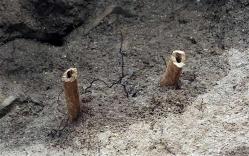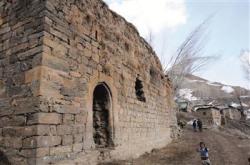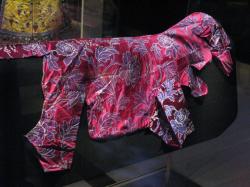INSTITUT SUPERIEUR D'ANTHROPOLOGIE
INSTITUTE OF ANTHROPOLOGY
ONLINE COURSES / COURS A DISTANCE
SPRING TERM : APRIL 2014
REGISTER NOW
ROYAUME UNI –  Monknash -The legs of an 800-year-old medieval monk have been discovered, poking out of a cliff face in Wales. Although badly damaged and missing their knees, shins and feet, the thigh bones were found after the fierce recent storms caused severe coastal erosion.The area of Monknash in South Wales was a burial ground for Cistercian monks in the Middle Ages. The valley is named after the Welsh saint Cewydd and was home to a community of Cistercian Monks from 1129 until the dissolution of the monasteries 1535.Human bones were discovered in the area in 1982, when a human long-bone was found, and then in 1990 part of a human skull was picked up. Three years later, excavations revealed three adults buried in an east-west line. The Cwm Nash Burial Ground is listed by the Royal Commission on the Ancient and Historical Monuments of Wales as an "unofficial burial ground used by parishioners of Monknash".
Monknash -The legs of an 800-year-old medieval monk have been discovered, poking out of a cliff face in Wales. Although badly damaged and missing their knees, shins and feet, the thigh bones were found after the fierce recent storms caused severe coastal erosion.The area of Monknash in South Wales was a burial ground for Cistercian monks in the Middle Ages. The valley is named after the Welsh saint Cewydd and was home to a community of Cistercian Monks from 1129 until the dissolution of the monasteries 1535.Human bones were discovered in the area in 1982, when a human long-bone was found, and then in 1990 part of a human skull was picked up. Three years later, excavations revealed three adults buried in an east-west line. The Cwm Nash Burial Ground is listed by the Royal Commission on the Ancient and Historical Monuments of Wales as an "unofficial burial ground used by parishioners of Monknash".
http://www.telegraph.co.uk/earth/environment/archaeology/10687989/800-year-old-monk-found-poking-out-of-cliff-face.html
ARGENTINE –  Terre de Feu - In a tale of archaeology with a bit of an Indiana Jones ring to it, researchers have identified new pieces of a 1765 shipwreck off Argentina—while traveling 125 miles of Tierra del Fuego on horseback. IANS reports that the team was on the hunt for pre-Columbian sites on the archipelago, which sits off the southernmost point of the mainland, roughly 2,200 miles from Buenos Aires. They uncovered wood, metal, and seven cannonballs from La Purisima Concepcion, a Spanish ship that was en route to Callao, Peru, and went down on Jan. 10 before reaching Cape Horn.The shipwreck, the oldest known in those parts, didn't end with all those aboard meeting a watery grave: Instead, many of the 193 who sailed on the Concepcion survived and spent two months ashore, where they lived among the natives and constructed smaller boats that took them to Buenos Aires, reports AFP, which adds that the archaeologists were able to determine exactly where the ship went down—though they're not telling. "It is not a galleon loaded with gold and pearls like in the movies; it's just a supply ship," says the lead archaeologist. "But we have chosen not to disclose the exact location so as not to encourage anyone to go souvenir hunting." Next up: a search for the castaways' campsite.
Terre de Feu - In a tale of archaeology with a bit of an Indiana Jones ring to it, researchers have identified new pieces of a 1765 shipwreck off Argentina—while traveling 125 miles of Tierra del Fuego on horseback. IANS reports that the team was on the hunt for pre-Columbian sites on the archipelago, which sits off the southernmost point of the mainland, roughly 2,200 miles from Buenos Aires. They uncovered wood, metal, and seven cannonballs from La Purisima Concepcion, a Spanish ship that was en route to Callao, Peru, and went down on Jan. 10 before reaching Cape Horn.The shipwreck, the oldest known in those parts, didn't end with all those aboard meeting a watery grave: Instead, many of the 193 who sailed on the Concepcion survived and spent two months ashore, where they lived among the natives and constructed smaller boats that took them to Buenos Aires, reports AFP, which adds that the archaeologists were able to determine exactly where the ship went down—though they're not telling. "It is not a galleon loaded with gold and pearls like in the movies; it's just a supply ship," says the lead archaeologist. "But we have chosen not to disclose the exact location so as not to encourage anyone to go souvenir hunting." Next up: a search for the castaways' campsite.
http://www.newser.com/story/183537/researchers-on-horseback-find-bits-of-1765-shipwreck.html?utm_source=syn&utm_medium=goognews&utm_campaign=chan3_feed
TURQUIE –  Korlu -A historical structure in the eastern province of Van, which once was an Armenian church, has been converted into a hayloft after serving as a school for some time. Villagers fill the former church in the Korlu village of the Çatak district, 30 kilometers from Van, with hay, grass, cowpat and wood, but they have personally appealed to authorities to renovate it. Villagers have attached a wooden door to the church, some parts of which are about to collapse, and tried to restore to prevent it from collapsing.
Korlu -A historical structure in the eastern province of Van, which once was an Armenian church, has been converted into a hayloft after serving as a school for some time. Villagers fill the former church in the Korlu village of the Çatak district, 30 kilometers from Van, with hay, grass, cowpat and wood, but they have personally appealed to authorities to renovate it. Villagers have attached a wooden door to the church, some parts of which are about to collapse, and tried to restore to prevent it from collapsing.
http://www.hurriyetdailynews.com/armenian-church--in-eastern-turkey-becomes-hayloft-after-serving-as-school.aspx?pageID=238&nID=63392&NewsCatID=375
CHINE –  Beijing - A canine named "Big Luck" (in translation) who lived in China's Forbidden City during the reign of the Guangxu Emperor (A.D. 1875-1908) wore this silk outfit. It would have covered Big Luck from snout to tail. Although the dog's breed is unknown, and the sex is uncertain, it appears to have been about 3 feet (1 meter) long and the outfit was decorated with images of peonies. It even has the dog's name inscribed on the lining.The Forbidden City is a palace complex containing about 980 buildings, and was home to China's emperors from 1420 to 1911. As its name suggests, the complex was off-limits to the public and could only be accessed by the emperor, his immediate family, the royal women and thousands of castrated male servants known as eunuchs.Unfortunately for the dogs, the days of living the high life were approaching their end around the time that Big Luck lived. The Qing Dynasty was falling into decline, the Qing military was becoming weaker relative to the western powers, and China was experiencing a great deal of civil strife.
Beijing - A canine named "Big Luck" (in translation) who lived in China's Forbidden City during the reign of the Guangxu Emperor (A.D. 1875-1908) wore this silk outfit. It would have covered Big Luck from snout to tail. Although the dog's breed is unknown, and the sex is uncertain, it appears to have been about 3 feet (1 meter) long and the outfit was decorated with images of peonies. It even has the dog's name inscribed on the lining.The Forbidden City is a palace complex containing about 980 buildings, and was home to China's emperors from 1420 to 1911. As its name suggests, the complex was off-limits to the public and could only be accessed by the emperor, his immediate family, the royal women and thousands of castrated male servants known as eunuchs.Unfortunately for the dogs, the days of living the high life were approaching their end around the time that Big Luck lived. The Qing Dynasty was falling into decline, the Qing military was becoming weaker relative to the western powers, and China was experiencing a great deal of civil strife.
http://www.livescience.com/43968-posh-dog-outfit-china-forbidden-city.html
FRANCE – Nantes -Zac de la Fontaine-aux-Bains. Par arrêté préfectoral, la direction régionale des Affaires culturelles a ordonné des fouilles supplémentaires suites aux fouilles préventives déjà effectuées sur le site qui avait révélé, entre autres, les traces d'un oppidum et la présence d'un village gaulois. Suivant les conditions météo, les fouilles devraient être réalisées entre avril et juin, sur 41 000 m2 .
http://www.ouest-france.fr/fouilles-supplementaires-zac-de-la-fontaine-aux-bains-1989728
FRANCE –  Ménéac - Des fouilles archéologiques ont été entamées au mois octobre sur le site du Val Bodron. Elles se poursuivent malgré des conditions météo déplorables. Le terrain est détrempé compliquant le travail de recherche et d'identification de l'Institut national de recherches archéologiques préventives (Inrap).En 2009, il a été relevé sur cette partie du territoire communal du Porhöet un vaste enclos agricole remontant à environ 250 ans avant J-C. Les fouilles actuelles s'étendent sur près de 3 ha. Les archéologues ont d'abord procédé au décapage de la terre végétale. Cela a permis, en fonction des natures et couleurs du sous-sol, d'identifier l'emplacement des constructions. Il s'agit d'un imposant enclos circulaire entouré de fossés servant à la fois de protection, drainages, voire de dépotoirs.Une plus petite surface intérieure était réservée à l'habitat. Il a été aussi répertorié un puits creusé dans le schiste et l'emplacement d'un grenier à céréales. Des fragments de poteries ont également été découverts. Ces derniers confirment la datation du site.
Ménéac - Des fouilles archéologiques ont été entamées au mois octobre sur le site du Val Bodron. Elles se poursuivent malgré des conditions météo déplorables. Le terrain est détrempé compliquant le travail de recherche et d'identification de l'Institut national de recherches archéologiques préventives (Inrap).En 2009, il a été relevé sur cette partie du territoire communal du Porhöet un vaste enclos agricole remontant à environ 250 ans avant J-C. Les fouilles actuelles s'étendent sur près de 3 ha. Les archéologues ont d'abord procédé au décapage de la terre végétale. Cela a permis, en fonction des natures et couleurs du sous-sol, d'identifier l'emplacement des constructions. Il s'agit d'un imposant enclos circulaire entouré de fossés servant à la fois de protection, drainages, voire de dépotoirs.Une plus petite surface intérieure était réservée à l'habitat. Il a été aussi répertorié un puits creusé dans le schiste et l'emplacement d'un grenier à céréales. Des fragments de poteries ont également été découverts. Ces derniers confirment la datation du site.
http://www.ouest-france.fr/des-fouilles-archeologiques-au-hameau-du-val-bodron-1876869
FRANCE –  Rennes - Les archéologues de l’Inrap ont effectué une nouvelle découverte, place Sainte-Anne, au coeur du centre historique de Rennes.« Ils ont mis au jour le sol d’un grand bâtiment pouvant être interprété comme l’un des éléments du premier espace public de Rennes, le forum de la cité émergente des Riédons, expliquent les équipes de l’Institut de recherches archéologiques préventives (Inrap). Il fait partie des plus anciens vestiges antiques mis au jour à Rennes. » Ces derniers mois, les fouilles avaient déjà permis de mettre au jour des sépultures anciennes, car le site abritait autrefois le cimetière de l’ancien hôpital Sainte-Anne, fondé par une confrérie en 1340 et qui a fonctionné jusqu’au milieu du XVIe siècle.
Rennes - Les archéologues de l’Inrap ont effectué une nouvelle découverte, place Sainte-Anne, au coeur du centre historique de Rennes.« Ils ont mis au jour le sol d’un grand bâtiment pouvant être interprété comme l’un des éléments du premier espace public de Rennes, le forum de la cité émergente des Riédons, expliquent les équipes de l’Institut de recherches archéologiques préventives (Inrap). Il fait partie des plus anciens vestiges antiques mis au jour à Rennes. » Ces derniers mois, les fouilles avaient déjà permis de mettre au jour des sépultures anciennes, car le site abritait autrefois le cimetière de l’ancien hôpital Sainte-Anne, fondé par une confrérie en 1340 et qui a fonctionné jusqu’au milieu du XVIe siècle.
http://www.ouest-france.fr/archeologie-la-plus-ancienne-place-publique-de-rennes-decouverte-1922393
FRANCE – Aubigny - Depuis le 6 janvier, une équipe de sept techniciens de l'Institut national de recherches archéologiques préventives (Inrap) est au travail sur la quatrième tranche du lotissement de la Belle-Étoile.Après la première campagne de fouilles réalisées en 2009-2010 dans le même lotissement et qui avait mis en évidence un site gallo-romain occupé par une famille de notables durant le second âge de fer (-100 ans à + 50 ans environ), les recherches effectuées actuellement ont permis de trouver des éléments complétant ce premier site. Pas de traces de bâtiments d'habitation à proprement parlé, mais des éléments révélant l'emplacement de bâtiments agricoles délimités par un fossé ainsi qu'un puits. Il pourrait s'agir d'une cour extérieure réservée aux travaux agricoles et au petit bétail attenant à l'espace consacré à l'habitat découvert en 2010. Les archéologues ont trouvé de nombreuses pièces de poterie, majoritairement de fabrication traditionnelle gauloise, peu de poteries plus recherchées d'importation gallo-romaines, comme sur le premier site de fouille, ce qui accrédite l'hypothèse d'un espace de service.
http://www.ouest-france.fr/fouilles-la-belle-etoile-des-traces-de-batiments-agricoles-1935475